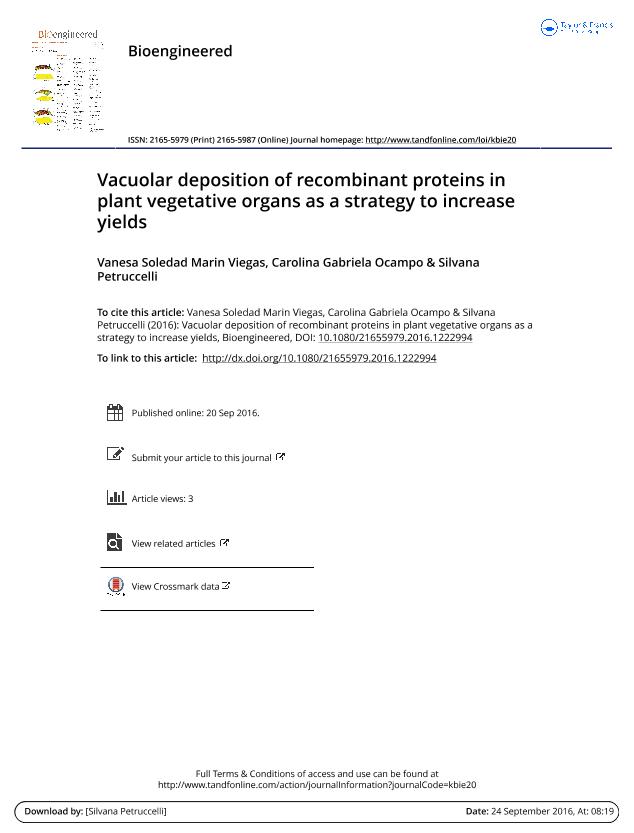Mostrar el registro sencillo del ítem
dc.contributor.author
Marin Viegas, Vanesa Soledad

dc.contributor.author
Ocampo, Carolina Gabriela

dc.contributor.author
Petruccelli, Silvana

dc.date.available
2018-07-05T16:48:52Z
dc.date.issued
2017-05
dc.identifier.citation
Marin Viegas, Vanesa Soledad; Ocampo, Carolina Gabriela; Petruccelli, Silvana; Vacuolar deposition of recombinant proteins in plant vegetative organs as a strategy to increase yields; Taylor ; Bioengineered; 8; 3; 5-2017; 203-211
dc.identifier.issn
2165-5987
dc.identifier.uri
http://hdl.handle.net/11336/51356
dc.description.abstract
Delivery of recombinant proteins to vegetative tissue vacuoles was considered inconvenient since this compartment was expected to be hydrolytic; nevertheless there is growing evidence that certain foreign proteins accumulate at high yields in vacuoles. For example avidin, cellulolytic enzymes, endolysin, and transglutaminases were produced at high yields when were sorted to leaf central vacuole avoiding the detrimental effect of these proteins on plant growth. Also, several secretory mammalian proteins such as collagen, α1-proteinase inhibitor, complement-5a, interleukin-6 and immunoglobulins accumulated at higher yields in leaf vacuoles than in the apoplast or cytosol. To reach this final destination, fusions to sequence specific vacuolar sorting signals (ssVSS) typical of proteases or proteinase inhibitors and/or Ct-VSS representative of storage proteins or plant lectins were used and both types of motifs were capable to increase accumulation. Importantly, the type of VSSs or position, either the N or C-terminus, did not alter protein stability, levels or pos-translational modifications. Vacuolar sorted glycoproteins had different type of oligosaccharides indicating that foreign proteins reached the vacuole by 2 different pathways: direct transport from the ER, bypassing the Golgi (high mannose oligosaccharides decorated proteins) or trafficking through the Golgi (Complex oligosaccharide containing proteins). In addition, some glycoproteins lacked of paucimannosidic oligosaccharides suggesting that vacuolar trimming of glycans did not occur. Enhanced accumulation of foreign proteins fused to VSS occurred in several plant species such as tobacco, Nicotiana benthamiana, sugarcane, tomato and in carrot and the obtained results were influenced by plant physiological state. Ten different foreign proteins fused to vacuolar sorting accumulated at higher levels than their apoplastic or cytosolic counterparts. For proteins with cytotoxic effects vacuolar sorted forms yields were superior than ER retained variants, but for other proteins the results were the opposite an there were also examples of similar levels for ER and vacuolar variants. In conclusion vacuolar sorting in vegetative tissues is a satisfactory strategy to enhance protein yields that can be used in several plant species.
dc.format
application/pdf
dc.language.iso
eng
dc.publisher
Taylor

dc.rights
info:eu-repo/semantics/openAccess
dc.rights.uri
https://creativecommons.org/licenses/by-nc-sa/2.5/ar/
dc.subject
Foreign Proteins
dc.subject
Leaf Central Vacuole
dc.subject
Lytic Vacuoles
dc.subject
Plant Molecular Farming
dc.subject
Proteolysis
dc.subject
Secretory Pathway
dc.subject
Storage Vacuoles
dc.subject
Vacuolar Deposition
dc.subject
Vacuolar Sorting Signals
dc.subject
Vegetative Tissue
dc.subject.classification
Otras Ciencias Biológicas

dc.subject.classification
Ciencias Biológicas

dc.subject.classification
CIENCIAS NATURALES Y EXACTAS

dc.title
Vacuolar deposition of recombinant proteins in plant vegetative organs as a strategy to increase yields
dc.type
info:eu-repo/semantics/article
dc.type
info:ar-repo/semantics/artículo
dc.type
info:eu-repo/semantics/publishedVersion
dc.date.updated
2018-06-25T01:04:39Z
dc.journal.volume
8
dc.journal.number
3
dc.journal.pagination
203-211
dc.journal.pais
Reino Unido

dc.journal.ciudad
Londres
dc.description.fil
Fil: Marin Viegas, Vanesa Soledad. Provincia de Buenos Aires. Gobernación. Comisión de Investigaciones Científicas. Centro de Investigación y Desarrollo en Criotecnología de Alimentos. Consejo Nacional de Investigaciones Científicas y Técnicas. Centro Científico Tecnológico Conicet - La Plata. Centro de Investigación y Desarrollo en Criotecnología de Alimentos. Universidad Nacional de La Plata. Facultad de Ciencias Exactas. Centro de Investigación y Desarrollo en Criotecnología de Alimentos; Argentina
dc.description.fil
Fil: Ocampo, Carolina Gabriela. Provincia de Buenos Aires. Gobernación. Comisión de Investigaciones Científicas. Centro de Investigación y Desarrollo en Criotecnología de Alimentos. Consejo Nacional de Investigaciones Científicas y Técnicas. Centro Científico Tecnológico Conicet - La Plata. Centro de Investigación y Desarrollo en Criotecnología de Alimentos. Universidad Nacional de La Plata. Facultad de Ciencias Exactas. Centro de Investigación y Desarrollo en Criotecnología de Alimentos; Argentina
dc.description.fil
Fil: Petruccelli, Silvana. Provincia de Buenos Aires. Gobernación. Comisión de Investigaciones Científicas. Centro de Investigación y Desarrollo en Criotecnología de Alimentos. Consejo Nacional de Investigaciones Científicas y Técnicas. Centro Científico Tecnológico Conicet - La Plata. Centro de Investigación y Desarrollo en Criotecnología de Alimentos. Universidad Nacional de La Plata. Facultad de Ciencias Exactas. Centro de Investigación y Desarrollo en Criotecnología de Alimentos; Argentina
dc.journal.title
Bioengineered
dc.relation.alternativeid
info:eu-repo/semantics/altIdentifier/doi/https://dx.doi.org/10.1080/21655979.2016.1222994
dc.relation.alternativeid
info:eu-repo/semantics/altIdentifier/url/https://www.tandfonline.com/doi/full/10.1080/21655979.2016.1222994
Archivos asociados
